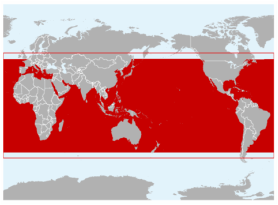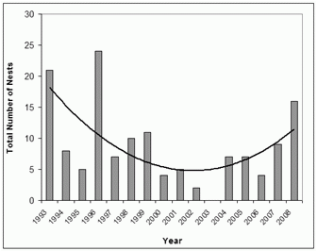Photo by Inaki Relanzon, www.arkive.org
 Hawksbill turtle range map./IUCN Species of the Day: Hawksbill Turtle
Hawksbill turtle range map./IUCN Species of the Day: Hawksbill Turtle
Background
Hawksbill turtle (Eretmochelys imbricata) is a kind of small to medium-sized sea turtle with a hawk-like beak and a fancy brown carapace. Hawksbill turtles are often found in the tropical waters of the Atlantic, Pacific and Indian Oceans and nest on the beaches of at least 60 countries (Linnaeus, 1776). They inhabit in shallow water where has many coral reefs around. The largest population of Hawksbill exist in Caribbean, the Republic of Seychelles, Indonesia and Australia(Hawksbill Turtle, NOAA Fisheries). The average body size of a adult hawksbill turtle ranges from 24 to 45 inches and weights usually between 100 to 150 lbs, but some may reach up to 3 ft and weight up to 300 lbs. Like other sea turtles, Hawksbills are well-known for their long life. Age at sexual maturity has been estimated as 20 or more years in the Caribbean and eventually they can live up to 50 years (Hawksbill Sea Turtle fact sheet, U.S. Fish&Wildlife Service, North Florida Ecological Service Office). They primary feed on jellyfishes and sponges. Nesting season varies geographically. For Hawksbills in Atlantic ocean, the nesting season is between April and November and in Indian ocean area, the nesting season occurs from September to February of the following year.(Hawksbill sea turtle fact sheet,U.S. Fish and Wildlife Service, North Florida Ecological Services Office) Usually, female Hawksbills prefer to nest at a quite and dark night and, on average, about 4.5 times per season at intervals of approximately 14 days. According to records, in Florida and the U.S. Caribbean, the approximate clutch size is 140 eggs, and sometimes over 200 eggs per nest if the conditions are optimal(Hawksbill sea turtle fact sheet).
Hawksbill turtle (Eretmochelys imbricata) is a kind of small to medium-sized sea turtle with a hawk-like beak and a fancy brown carapace. Hawksbill turtles are often found in the tropical waters of the Atlantic, Pacific and Indian Oceans and nest on the beaches of at least 60 countries (Linnaeus, 1776). They inhabit in shallow water where has many coral reefs around. The largest population of Hawksbill exist in Caribbean, the Republic of Seychelles, Indonesia and Australia(Hawksbill Turtle, NOAA Fisheries). The average body size of a adult hawksbill turtle ranges from 24 to 45 inches and weights usually between 100 to 150 lbs, but some may reach up to 3 ft and weight up to 300 lbs. Like other sea turtles, Hawksbills are well-known for their long life. Age at sexual maturity has been estimated as 20 or more years in the Caribbean and eventually they can live up to 50 years (Hawksbill Sea Turtle fact sheet, U.S. Fish&Wildlife Service, North Florida Ecological Service Office). They primary feed on jellyfishes and sponges. Nesting season varies geographically. For Hawksbills in Atlantic ocean, the nesting season is between April and November and in Indian ocean area, the nesting season occurs from September to February of the following year.(Hawksbill sea turtle fact sheet,U.S. Fish and Wildlife Service, North Florida Ecological Services Office) Usually, female Hawksbills prefer to nest at a quite and dark night and, on average, about 4.5 times per season at intervals of approximately 14 days. According to records, in Florida and the U.S. Caribbean, the approximate clutch size is 140 eggs, and sometimes over 200 eggs per nest if the conditions are optimal(Hawksbill sea turtle fact sheet).
 Total (adjusted) number of hawksbill turtle nests deposited per annum in the Chagar Hutang Turtle Sanctuary from 1993 - 2008. The figures have been extrapolated from actual number of nests deposited for periods ranging from four to 12 months each year.
Total (adjusted) number of hawksbill turtle nests deposited per annum in the Chagar Hutang Turtle Sanctuary from 1993 - 2008. The figures have been extrapolated from actual number of nests deposited for periods ranging from four to 12 months each year.
Although this species is widely distributed, it does not mean that their population size is large. In many parts of the world, Hawksbill population have continued to decline since this species first appeared in the IUNC Red List of Threatened Species first as endangered species in 1982 (Groombridge,B.,1982), and have not yet been removed from the list. In 1996, the status of Hawksbill was upgraded to critically endangered. It's difficult to estimate the global number of Hawksbill turtles but it is sure that the number has drastically declined, probably by as much as 80% over the last century (Marine Turtle Specialist Group). Hawksbills face many natural threats to their survivals. Young Hawksbills are particularly vulnerable because they have many predators such as crabs, birds, raccoons (eat the eggs), and sharks (Threats to sea turtles, Wildlife Conservation Society). Several other human-caused threats accelerate the population decline: habitat loss and degradation, wildlife trade, collection of eggs and meat for consumption, incidental capture, climate change and pollution (Threats to sea turtles, Wildlife Conservation Society). Among all, habitat loss and degradation, wildlife trade and pollution are three biggest threats that our poor little hawksbills are facing(WWF).
A 16-year (from 1993 to 2008) record of green and hawksbill turtle nesting activity at Chagar Hutang Turtle Sanctuary, Redang Island, Malaysia shows that the total nesting Hawksbills went down from 1993 to 2003 but grew up after 2004(Eng-Heng Chan, July 2010). The recovering in population is due to effective conservational actions done by governmental agencies and many organizations.
A 16-year (from 1993 to 2008) record of green and hawksbill turtle nesting activity at Chagar Hutang Turtle Sanctuary, Redang Island, Malaysia shows that the total nesting Hawksbills went down from 1993 to 2003 but grew up after 2004(Eng-Heng Chan, July 2010). The recovering in population is due to effective conservational actions done by governmental agencies and many organizations.

